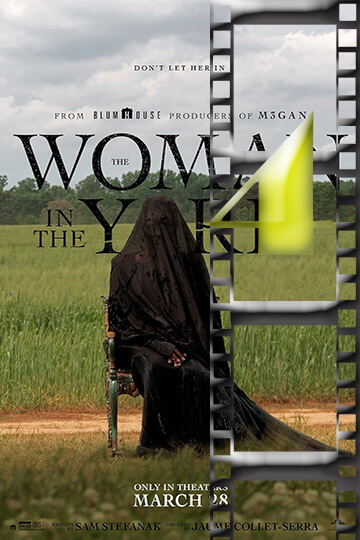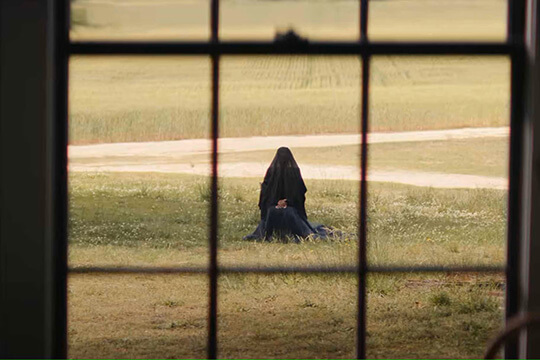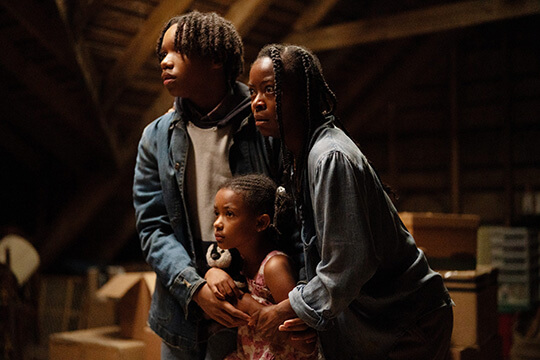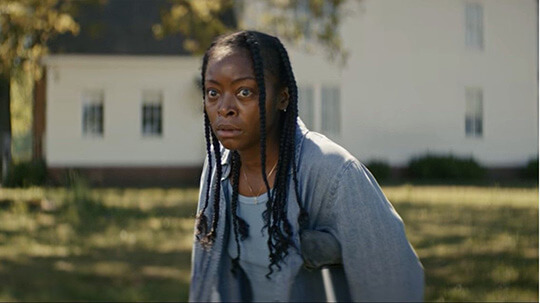



What’s It About
Ramona becomes crippled by grief after her husband dies in a car accident, leaving her to care for her two children alone in her rural farmhouse. Her sadness soon turns to fear when a spectral woman in black appears on her front lawn, warning her “today’s the day.” As the mysterious figure creeps closer and closer to the house, Ramona realizes she must protect her children from the evil woman who simply won’t leave them alone.



MOVIESinMO REVIEW
Let me explain – the newest thriller from Blumhouse, “The Woman in the Yard,” had my attention from the first scene. A woman with no face dressed in black simply… resting on a chair in someone’s backyard? That is the type of setup that creeps me out. Sadly, this is where the film loses traction in turning its plausible concept into something unforgettable. Subtlety has never been Blumhouse’s strong suit, as explained above. Danielle Deadwyler plays Ramona, a widow, evidently limping on a leg brace after a car collision that killed her husband. Now she’s waiting out in a decaying farmhouse in buttfuck Georgia with her two children, the caretaker of a family with a 14-year-old named Tay (Peyton Jackson) and 6-year-old Annie (Estella Kahiha). The family is suffocating with grief. Ramona seems so distraught that she is immobile. Bills have yet to be paid, there’s no power being run, and the pieces of a car from the fatal accident that killed her husband are under a tarp in the yard. Then, one day… THE woman appeared. Just sitting in their yard. Dressed in all black with a veil covering her face, Okwui Okpokwasili portrays her with unsettling stillness. When confronted, she simply states, “Today’s the day,” and refuses to leave. As tensions rise, the woman seems to inch closer to the house whenever no one’s looking. Director Jaume Collet-Serra (known for “Orphan” and “The Shallows”) knows how to create atmosphere. The farmhouse feels isolated and vulnerable, and cinematographer Pawel Pogorzelski paints the screen with a sense of dread. Even simple tasks like Tay trying to light the gas stove become anxiety-inducing moments. The visual composition, when focusing on the woman in black – motionless but threatening – creates genuine unease. Deadwyler delivers a powerful performance that deserves a better movie. She fully embodies a woman crushed by loss, trapped between paralyzing depression and the responsibility of caring for her children. The pain in her eyes tells stories that the script barely touches. But here’s where things fall apart. The movie spends too much time going in circles – characters arguing about the woman, noticing she’s moved closer, but not much actually happening. The pacing drags, and by the time we get to the inevitable confrontation, the film shifts into confused supernatural territory. The woman can apparently manipulate shadows to cause harm, but the rules feel inconsistent and hastily established. It becomes clear that the woman in black is meant to be a metaphor for Ramona’s grief and guilt – which should be powerful in theory. However, the film attempts to juggle both narratives, forcing her to be both a psychological manifestation and a supernatural threat. This muddled narrative takes away from a much more impactful narrative of mourning and moving on. What aggravates me most is that this is wasted potential. There’s a brief moment where the film touches on something truly disturbing about what the woman represents, something raw and honest about the darker sides of loss, but it quickly retreats back to familiar horror tropes and confusing plot twists. By the third act, I found myself more bewildered than frightened. The story twists itself into knots trying to be clever, leaving me unsure what was real and what wasn’t – and not in the intentional, thought-provoking way that great psychological horror achieves. For all its atmospheric cinematography and Deadwyler’s committed performance, “The Woman in the Yard” never shifts out of neutral. It’s like watching someone with incredible ingredients cook a bland meal. The pieces for something special are there: grief, isolation, the visual of that haunting figure slowly approaching – but they never come together cohesively. If you’re looking for a decent horror film featuring Danielle Deadwyler, you might want to check out “The Piano Lesson” on Netflix instead. While technically more of a drama with supernatural elements than straight horror, it offers a more satisfying experience. “The Woman in the Yard” feels like it’s trying to follow in the footsteps of recent elevated horror that uses supernatural elements to explore trauma and grief – think “The Babadook” or “Hereditary” – but it lacks the emotional and narrative clarity that made those films work. What we’re left with is a beautifully shot but ultimately hollow experience that, like its central figure, just sits there without really going anywhere. Deadwyler deserves praise for bringing such authenticity to her role, but even her talents can’t save a film that doesn’t know what it wants to be. “The Woman in the Yard” had the chance to be a powerful meditation on loss wrapped in horror packaging, but instead, it ends up being as vague and frustrating as its mysterious visitor.
OUR RATING – A PAINFULLY SLOW 4

